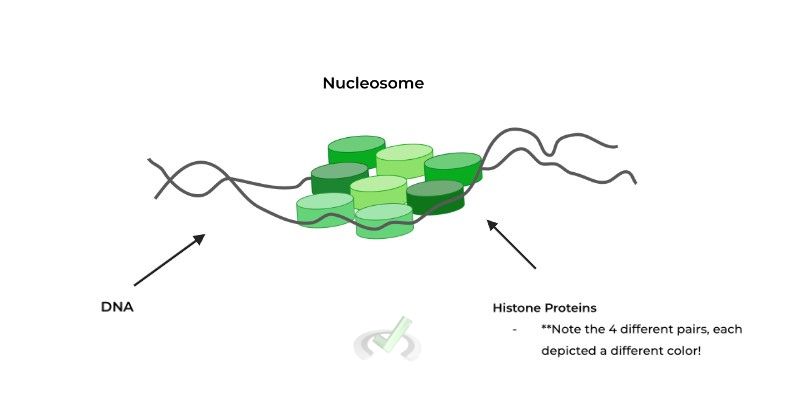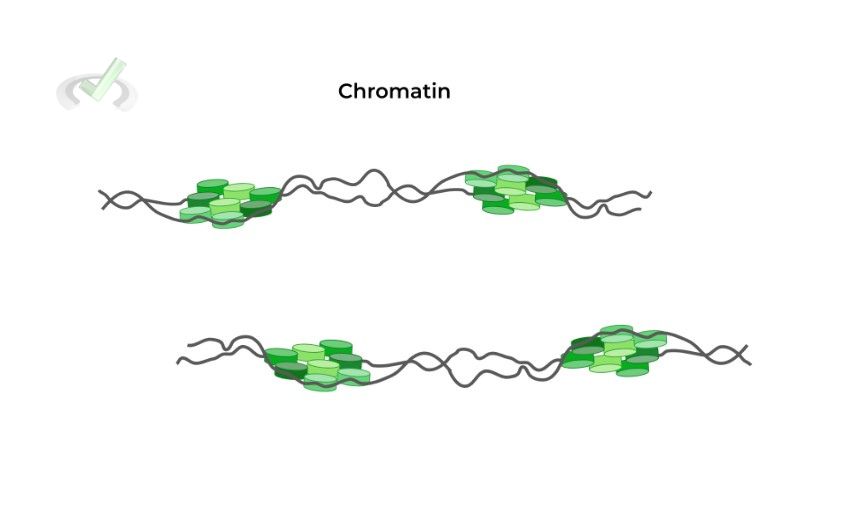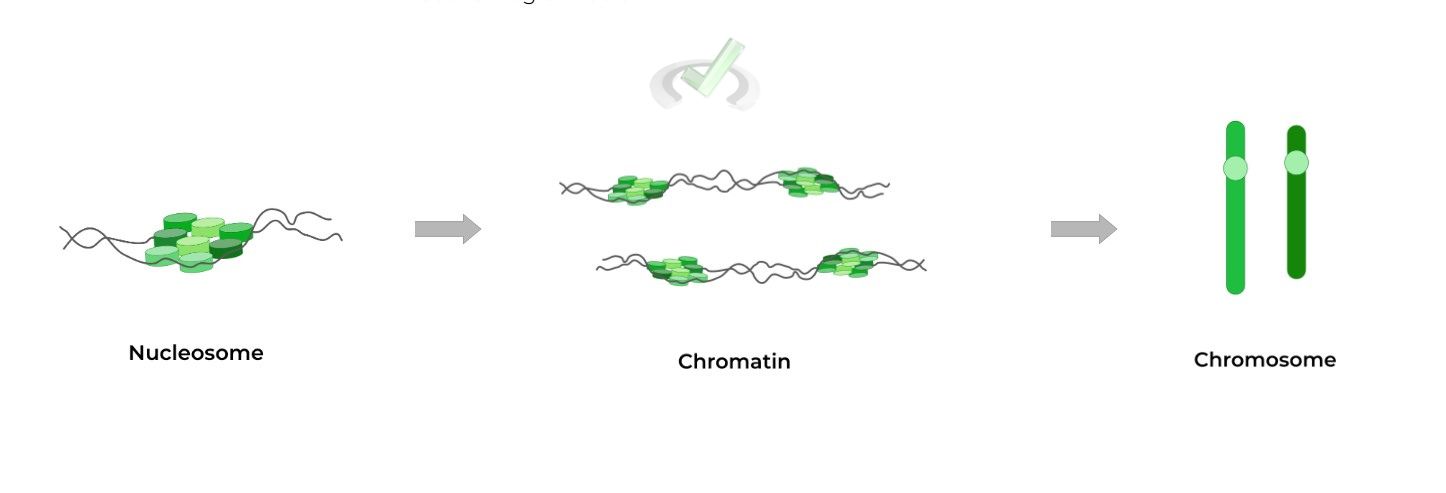I. What is Chromosomal Structure and Function?
With all the 23andMe and My Heritage DNA companies promoting the ability to discover your ethnic ancestry, it’s no wonder why chromosomes are such a hot topic nowadays! Trust us, we’ve also been tempted to take one of these tests (the $170 selling price was a bit too steep 
Aside from this, chromosomes are highly important in regards to the organization of DNA in the cell and during cell division! With over 3 billion base pairs in our genomes, it’s thanks to chromosomes that we can put all these As, Ts, Cs, and Gs into the nucleus!
Furthermore, take this article also as the foundation for understanding other topics, particularly genetics and gene expression! This will be more evident once getting into the passage, but we can’t stress enough the importance of connecting topics with one another during MCAT prep!
II. Eukaryotic Chromosome Organization: Chromosomal Protein
As stated above, the main role of the chromosomes is to serve as a mode of organization of the DNA in the cell. Let’s first outline the building blocks to how DNA is organized to create chromosomes.
A. Nucleosomes
The chromosome isn’t just composed of purely DNA, but also has proteins that associate with the DNA molecule! Specifically, these proteins are called histones.
Histones interact with DNA’s phosphate backbone and have 2 main functions in regards to their inclusion in chromosome structure: 1) serve as an anchoring point to pack the DNA and 2) regulating gene expression!
In addition, nucleosomes are specifically composed of 1) 4 pairs of histone proteins (8 in total) and 2) the DNA molecule. One way to think of nucleosomes is as the basic structural unit of chromosomes, as numerous nucleosomes constitute the chromosome.
B. Chromatin v.s. Chromosome
Oftentimes, there can be confusion between these 2 terms because they’re so similar in terms of the lettering and their definition, but don’t worry! We’ll try to break them down as simply as possible!
I. Chromatin
This term can be thought of as either: 1) describing the DNA molecule wrapped around the histone proteins or 2) the form of DNA during interphase (i.e. when the cell is not dividing).
In general, we prefer the 2nd definition as it gives you a better idea of when the DNA is in its chromatin form by giving you a cellular context.
Here, chromatin is the main form of DNA that’s present when the cell is going about its basic function and not dividing, making chromatin conducive for various cellular processes such as gene expression, transcription, etc.
Note how nucleosomes are the basic structural units which form chromatin, which follows the definition outlined earlier.
II. Chromosome
This term is utilized when DNA is in its most condensed and organized form. This is because the DNA takes on this form when undergoing mitosis and meiosis, specifically during the metaphase & anaphase.
Because they’re condensed, they ARE NOT able to participate in cellular processes such as gene expression & transcription.
This makes sense because during mitosis/meiosis, the cell shouldn’t be undergoing the above mentioned topics as it should just be undergoing cell division. Take a look at the diagram below!

Another point of emphasis is that nucleosomes are both present in chromatin and chromosomes! Remember: the difference between chromatin and chromosomes is in their condensed state and at which point in the cell cycle a certain form dominates.
III. Bridge/Overlap
As stated prior, histones are not just involved in packing the DNA, but also in regulating the expression of genes! How does it do it without affecting the DNA sequence? This is where the study of epigenetics comes in.
I. Epigenetics: Euchromatin v.s Heterochromatin
Epigenetics refers to how cellular gene expression can be altered without changes in the DNA sequence. Here, histones can regulate gene expression through changes in their interaction with DNA.
Specific modifications to the histone proteins can either make DNA easier or harder to transcribe, termed euchromatin and heterochromatin, respectively.
In simple terms, you can think of the euchromatin conformation as being the “open” conformation while the heterochromatin conformation is the “closed” conformation.
Think of it as euchromatin being “open” for transcription while heterochromatin is “closed” for transcription!
IV. Wrap Up/Key Terms
Let’s take this time to wrap up & concisely summarize what we covered above in the article!
A. Nucleosomes
The chromosome doesn’t just consist of pure DNA, but also contains histone proteins which interact with the phosphate backbone.
Histone interaction with DNA serves 2 functions: 1) acts as an anchoring point to pack DNA and 2) regulating gene expression such as in the study of epigenetics!
The nucleosome is the basic structural unit of chromosomes/chromatin. These DNA-protein complexes consist of: 1) 4 pairs of histone proteins (8 in total) and 2) the DNA molecule.B. Chromatin v.s. Chromosomes
These 2 terminologies can often be confusing due to the similarity of their lettering as well as their definition, but do have distinct features!
A point of emphasis to make is that nucleosomes make up the basic structural units for both chromatin and chromosomes!
I. Chromatin
This term can either: 1) describe the DNA molecule wrapped around histone proteins or 2) the form of DNA during interphase (i.e. when the cell is not dividing).
You can use this term to picture the DNA going about normal, cellular function such as transcription and gene expression.
II. Chromosome
This term refers to when the DNA is in its most condensed and organized form, dominating during the processes of mitosis and meiosis.
It makes sense that this is the dominating form during mitosis and meiosis as processes such as transcription and gene expression should not be occurring.
V. Practice
Take a look at these practice questions to see and solidify your understanding!
Sample Practice Question 1:
Insulin is a peptide hormone expressed in order to promote the decrease in blood sugar; glucagon is also a peptide hormone but is expressed in order to promote an increase in blood sugar. After eating a meal full of candy, the gene expression for insulin would be expected to have a ___________ state while glucagon would be expected to have a ___________ state.
A. Euchromatin,. Euchromatin
B. Heterochromatin, Heterochromatin
C. Euchromatin, Heterochromatin
D. Heterochromatin, Euchromatin
Ans. C
Because we’re eating a meal high in sugar, we would expect the blood sugar to increase. In order to maintain homeostasis, we need to promote a DECREASE in blood sugar so as to prevent hyperglycemia (high blood glucose).
Euchromatin promotes the ACTIVE transcription of a gene while heterochromatin PREVENTS transcription of a gene.
Therefore, the gene coding for insulin production should have an euchromatin conformation while the gene coding for glucagon production should have a heterochromatin conformation.
Sample Practice Question 2:
Which amino acids are expected to be present on the histone proteins of the nucleosomes?
A. Aspartate, Glutamate
B. Histidine, Arginine
C. Leucine, Glycine
D. Phenylalanine, Isoleucine
Ans. B
This is a great example of how the MCAT likes to test topics: synthesizing multiple topics and subjects into one question to test if you can see the overlap between them.
Recall that the histone proteins interact with the phosphate backbone of DNA, which is NEGATIVELY charged! As such, histone proteins should have positively charged amino acids in order to promote a favorable electrostatic interaction.







 To help you achieve your goal MCAT score, we take turns hosting these
To help you achieve your goal MCAT score, we take turns hosting these 





















 reviews on TrustPilot
reviews on TrustPilot